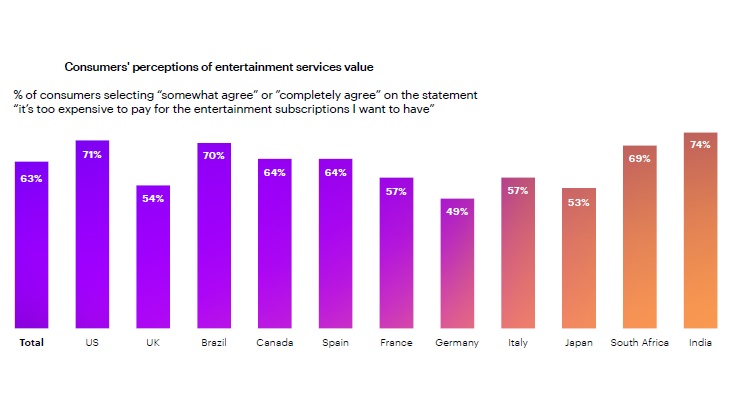Streaming’s Future May Look Like Cable, Accenture Says
Aggregators needed to make content easier to find

A new report from Accenture said consumers are complaining about streaming getting to be more like cable and, ironically, that cable operators are among the potential aggregators that could solve some of the issues facing the industry.
According to Accenture’s survey, consumers feel they’re paying a lot for content they never watch and they’re not interested in — something they used to say about cable. When consumers were asked what percentage of content provided by five major streaming services is relevant to them, no service topped 40%.
“That’s not far off from what we found consumers thought about the content they paid for from their cable providers a few years ago,” Accenture said in its report, titled Streaming’s Next Act.
The survey also found what Accenture called “a widening price-value mismatch in streaming.” The survey found that 63% of consumers say the entertainment subscriptions they want are too expensive. At the same time, 62% expected streaming entertainment would be cheaper because of Netflix’s once-low price. Now, they find, watching video is just as expensive as it’s always been.
Consumers don’t see things getting better, with 70% of those survey saying they expect streaming services to continue to raise prices.
Accenture points to three core issues consumers complain about that it says are eroding the consumer streaming experience.
Consumers gripe about frustrating “rabbit holes” in streaming services — inefficient, increasingly expensive bundles and scattered algorithms that make it hard to find programming they want to watch and that turn a pleasant evening in front of the tube into an expensive, unwieldy experience.
Broadcasting & Cable Newsletter
The smarter way to stay on top of broadcasting and cable industry. Sign up below
Navigation Frustrations
In its global survey, Accenture found that 60% of consumers said they consider navigating between different streaming services to find content “a little” to “very frustrating.” Half of those surveyed said they spend more than six minutes trying to find something to watch.
The more services a consumer sues, the more frustrated they get, with 65% of those with four or more services saying they’re frustrated, compared to 60% who use just one.
That makes search engines that search across multiple services attractive to 58% of those surveyed.
The growing expense of streaming is also a problem, with 33% of consumers saying they will “somewhat” or “greatly” decrease their spending on subscriptions and one-time purchase in the next 12 months.
Just 34% of consumers said they were interested in adding new services, according to the survey.
Accenture also found that streaming service algorithms are working with incomplete viewing data, resulting in recommendations that can be wildly off base.
Most consumers said they’d like their viewing profiles to work across services and that they would be OK with services knowing more about them in order to make recommendations more relevant.
Consumer suggestions for improving recommendations included letting them choose the genre they want to watch, basing recommendations on the popularity of content, their mood or what friends and family are watching.

Accenture suggests that streaming needs a smart aggregator that works across multiple platforms and gives consumers more control over the content they watch.
The media industry is aware of these issues, Accenture said. In its Technology Vision 2021 research, 77% of media executives said their companies need to dramatically re-engineer the experiences that bring technology and people together in a way that puts people first.
Accenture’s prescriptions involve finding apps and data-sharing agreements that work across streaming services and act as a single platform that enables viewers to watch what they want regardless of who is providing it. The system should also personalize navigation, curating the experience for each user.
Who will take on the role of aggregator? Accenture said it could be the subscription video-on-demand services, of course, or connected-TV device makers, internet on-ramps, consumer apps or even cable operators.
Compared to the numerous streaming services today, the number of successful aggregators will be small.
“Platform economics — and the simple challenges of discovery — likely will rapidly push the world toward a small number of aggregators that can achieve outsized financials through economies of scope and scale leverage,” Accenture said. ”The numbers will only work for business models that can extract attractive rents from partner apps, subscriber fees and premium CPMs while amortizing largely fixed operating costs across a bigger and bigger base.”
Seeing a Need to Bundle Up
Accenture expects mini-bundles to form in the short term. In the longer term, it will be tough for any streaming service to survive without being part of a major bundle.
So will the streaming business look like the cable business?
“Perhaps, but it only achieves endgame equilibrium if the aggregators deliver on the promises of choice, personalization, and convenience,” Accenture said.
“As aggregators battle to own the ‘Time Spent’ of consumers, we can expect future evolutions to aspire to be the on-ramps for any form of digital consumer experience. In fact, as Time Spent comes to include the limitless possibilities of the metaverse, aggregators, if trusted, can be enablers and caretakers of digital identity, entitlements, security, currency, and more. Indeed, the battle to be the home of a consumer’s streaming experience may, in fact, be just the first skirmish in the broader battle to be the home of a consumer’s every experience,” Accenture said.
Accenture surveyed 6,000 consumers in North America, South America, Europe, South Africa and Asia Pacific. ■
Jon has been business editor of Broadcasting+Cable since 2010. He focuses on revenue-generating activities, including advertising and distribution, as well as executive intrigue and merger and acquisition activity. Just about any story is fair game, if a dollar sign can make its way into the article. Before B+C, Jon covered the industry for TVWeek, Cable World, Electronic Media, Advertising Age and The New York Post. A native New Yorker, Jon is hiding in plain sight in the suburbs of Chicago.

